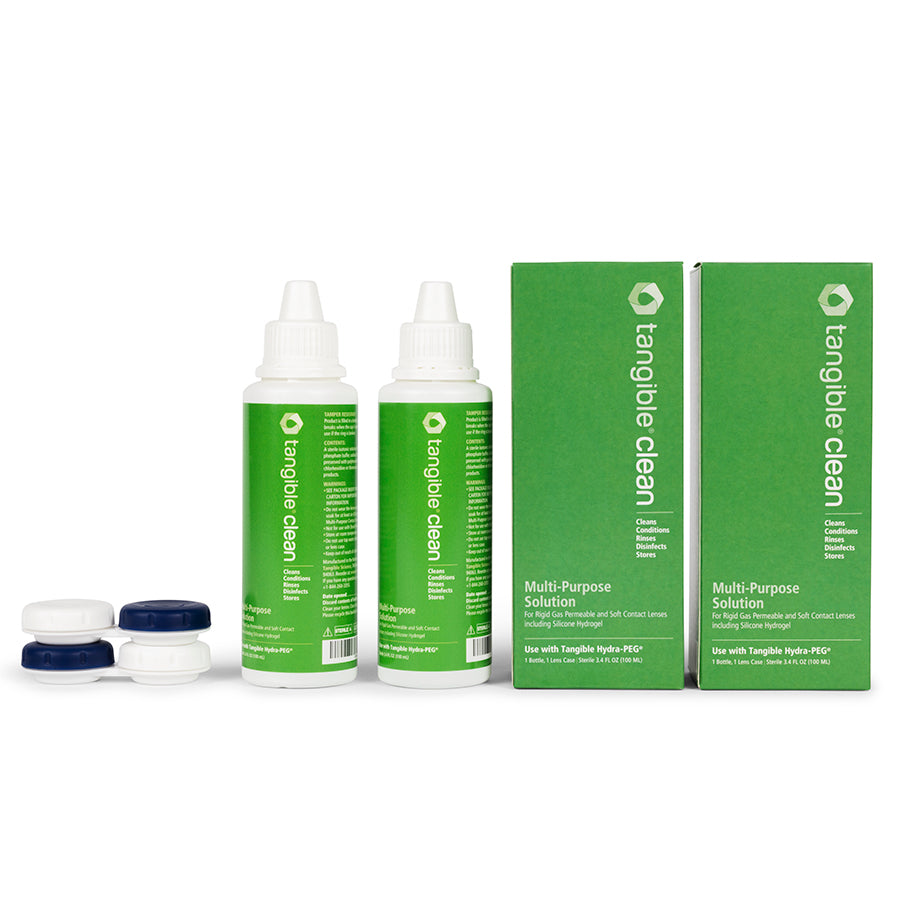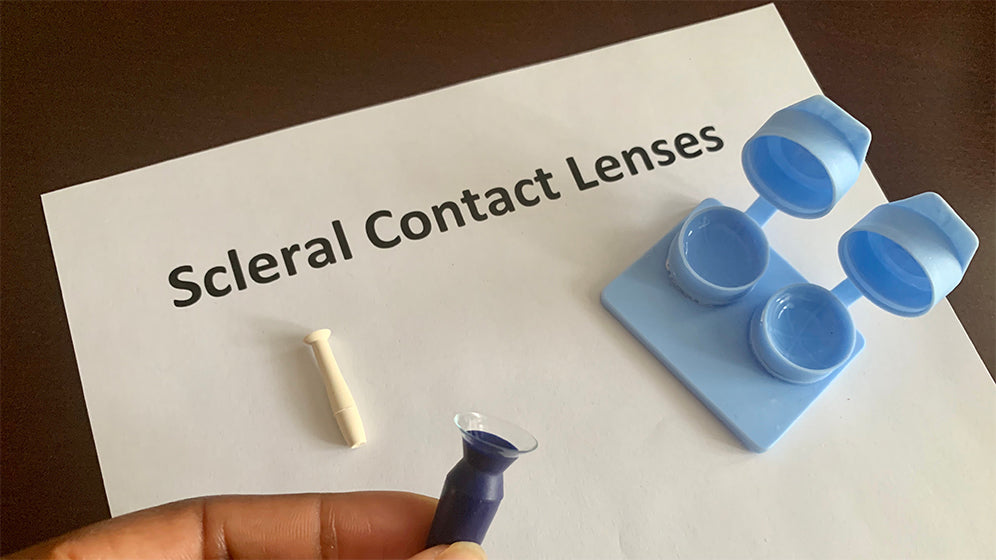Your cart is empty
Already have an account? Log in to check out faster.


This month, we had the pleasure of speaking with Dr. Jason Jedlicka on "Talking with Tangible". We had a VERY in depth conversation digging into dry eye, and using scleral lenses (with the addition of Tangible Hydra-PEG) to help care for patients.
We use scleral lenses to alleviate the symptoms of ocular surface disease for patients, we use scleral lenses to improve the visual quality for patients with ocular surface diseases in some cases, and we use scleral lenses to heal the ocular surface of patients with certain diseases. But we do not fix or cure the underlying dry eye disease whether it's severe MGD, or aqueous deficiency, or any type of inflammatory ocular surface disease. We are making the eye healthier underneath the lens, but we have all of the same issues to deal with in regards to ocular surface issue). Add to that fact, that we are putting this [scleral] lens on the eye, and propping the eye lids open wider thereby increasing the surface area of the eye that is exposed to evaporation. There is also no question that the lid wipers of the eye blinking across a plastic surface as opposed to the eye surface itself is a negative. The lid wipers are actually tighter closing over the surface of the lens than they are closing over the eye.
So the fact is we're not treating the dry eye or the underlying disease but we're treating the signs and symptoms of it, keeping the cornea healthy, and helping the patient have a better quality of life. On top of that, we're actually making the underlying issues kind of worse in some ways by taxing what little tears that are there. Putting a scleral lens on an ocular surface disease patient is life-changing in many ways, but it definitely comes with its drawbacks. On a patient where we have given them benefits with a scleral lens by keeping the cornea healthy, they could now be struggling with visual fluctuations with the lens surface not wetting correctly. In addition to that, the dry lens surface is much more vulnerable and will get hit harder by protein build-up where the lens is dry, and the areas where the eye is open between blinks.
The only way to do this of course, is to somehow provide a barrier to friction, dryness, and build-up on the surface of that lens. That is exactly what Tangible Hydra-PEG does. It deals with all the problems that we face with the dry eye and scleral lenses for those ocular surface disease patients.
The majority of patients, once they have worn Tangible Hydra-PEG coated lenses for a day or two, will notice how consistent the vision is. Patients won't notice that evaporation between blinks, and the fogging that comes with the surface of the lens drying. Any scleral lens wearer is going to have good vision with or without Tangible Hydra-PEG applied to their lens immediately after inserting their lens. After a couple hours however they will start to notice with a Tangible Hydra-PEG coated lens, it will keep that lens wet and keep that vision consistent. That's really the big benefit here, the consistency of the vision over the course of the wearing schedule.
In many ways, it would be easy enough to use Tangible Hydra-PEG with every single patient. But, in a lot of situations I don't initially. Most of the time when we order scleral lenses were going to have a remake in the first couple weeks to fine tune the fit or prescription. What I like to do is not order it on the first lens, unless the patient absolutely needs it. But as they come back for their follow-up and we're looking at reordering, we'll talk about adding it to the lens because we will already start to see the issues with the lens surface. So then on our reorder, most times, we will get that remake ordered with Tangible Hydra-PEG applied.
Then the patient is able to evaluate the coating and see the difference it is making for them. Almost universally we will not end up taking it off because they prefer their scleral lenses with the Hydra-PEG coating on. Doing it this way gives us the opportunity to "put it to the test", and have the patient notice the benefit that the coating is giving them. They'll end up saying "wow this lens feels a lot more comfortable when I blink", and feedback like that.
With sclerals I don't think it changes the fit. You can add it to current wearers without worrying that it's going to change anything, besides that surface wettability of course.
I do, and actually have one very recently. She was a Keratoconus patient and in scleral lenses for around 3-4 years. She had come in for an office visit earlier this year, with the complaint that she had blood in the corner of her eye when she was wearing her lens a few days prior. This eye was bothering her, and it felt dry and irritable. So she comes in, and we check out the surface and notice that it's definitely dry. There's no question, she blinks and within a second or two you can see the surface drying. We investigate further, and found out that the lid wiper had broken down and bled from irritation over the past couple days. The fit on the lens is great, there are no other issues with that lens at all other than the surface.
We ended up reordering her the exact same lens, but had Tangible Hydra-PEG applied in order to combat the surface issues. We just recently followed up with her again and she is experiencing no issues with the lens comfort, no more issues with bleeding, and saw improvements to her lid wiper in comparison to her old lens. I fully believe that having the Hydra-PEG there is what is making the difference. The added lubricity of having that coating layer over the lens, and allowing the lid wiper to blink over the lens with less friction is what made all the difference.
Dr Jedlicka is an Associate Professor at Indiana University School of Optometry, and the Director of the Cornea and Contact Lens Service. He is a Diplomate in the American Academy of Optometry's Cornea, Contact Lens, and Refractive Technologies Section, a past President of the Scleral Lens Education Society, and a Fellow and board member of the Contact Lens Society of America. He has contributed to multiple textbooks as an author on the topic of GP and scleral lenses. He is the developer of the Zenlens and ZenRC scleral lenses.
Interested in more information about Tangible Hydra-PEG or Tangible Clean? Subscribe to our newsletter below for new monthly insights on Tangible Hydra-PEG, and check out our product page on Tangible Clean (https://tangiblescience.com/product/tangible-clean/).
If you are interested in being on Talking with Tangible, please reach out to us directly at our contact-us page and we can discuss setting you up for a future interview! If you are interested in having specific topics discussed please don't hesitate to reach out as well.
-- Team Tangible


If you're experiencing discomfort with your scleral lenses, initiating a discussion with your Eye Care Provider is essential. It may seem... Read more

Now that you have made it home with your scleral lenses, it’s time to care for them. Pretty simple, right?... Read more

Struggling with scleral lens care? You're not alone. This ultimate guide is your one-stop resource for everything you need to... Read more

If you're experiencing discomfort with your scleral lenses, initiating a discussion with your Eye Care Provider is essential. It may seem... Read more

Now that you have made it home with your scleral lenses, it’s time to care for them. Pretty simple, right?... Read more

Struggling with scleral lens care? You're not alone. This ultimate guide is your one-stop resource for everything you need to... Read more
Stay up to date on the top scleral and RGP lens tips from our expert, NCLE certified staff.